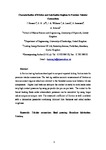Characterisation of friction and lubrication regimes in premium tubular connections
| dc.contributor.author | Stewart, F | |
| dc.contributor.author | Le, HR | |
| dc.contributor.author | Williams, JA | |
| dc.contributor.author | Leech, A | |
| dc.contributor.author | Bezensek, B | |
| dc.contributor.author | Roberts, A | |
| dc.date.accessioned | 2015-02-23T11:41:29Z | |
| dc.date.available | 2015-02-23T11:41:29Z | |
| dc.date.issued | 2012-09-01 | |
| dc.identifier.issn | 0301-679X | |
| dc.identifier.issn | 1879-2464 | |
| dc.identifier.uri | http://hdl.handle.net/10026.1/3259 | |
| dc.description | This was an outcome of a KTP project with oil engineering company looking into the important role of tribology in the reliability and performance of subsea oil/gas pipelines. I am the corresponding author. The paper commissioned a simple and efficient method to test friction and galling performance of various surface coatings and lubrication systems applied in premium oil/gas pipelines. The underlining science of friction and lubrication was uncovered based on the experimental results. This will reach wider academic community and industry such as seals, valves, bearings, water sewage pipelines, hydraulic pipelines who are concerned about the effect of tribology. | |
| dc.description.abstract |
A friction test rig has been developed to carry out repeated sliding friction tests for premium tubular connections. The test rig enables accurate measurement of friction in various contact regimes which are relevant to the threaded connections between tubular components. Higher load tests can simulate the contact in metal-to-metal seals under very high contact pressures by using perpendicular pin-on-pin tests. The contact in the thread loading flank under intermediate pressures can be simulated by using larger radius coupon-on-coupon tests. The measured coefficient of friction is well correlated with a lubrication parameter combining lubricant film thickness and initial surface roughness. | |
| dc.format.extent | 159-166 | |
| dc.language | en | |
| dc.language.iso | en | |
| dc.publisher | Elsevier BV | |
| dc.subject | Bead peening | |
| dc.subject | Boundary lubrication | |
| dc.subject | Friction | |
| dc.subject | Tubular connection | |
| dc.title | Characterisation of friction and lubrication regimes in premium tubular connections | |
| dc.type | journal-article | |
| dc.type | Article | |
| plymouth.author-url | http://gateway.webofknowledge.com/gateway/Gateway.cgi?GWVersion=2&SrcApp=PARTNER_APP&SrcAuth=LinksAMR&KeyUT=000305855900019&DestLinkType=FullRecord&DestApp=ALL_WOS&UsrCustomerID=11bb513d99f797142bcfeffcc58ea008 | |
| plymouth.volume | 53 | |
| plymouth.publication-status | Published | |
| plymouth.journal | TRIBOLOGY INTERNATIONAL | |
| dc.identifier.doi | 10.1016/j.triboint.2012.04.011 | |
| plymouth.organisational-group | /Plymouth | |
| plymouth.organisational-group | /Plymouth/Research Groups | |
| plymouth.organisational-group | /Plymouth/Research Groups/Marine Institute | |
| dcterms.dateAccepted | 2012-04-05 | |
| dc.identifier.eissn | 1879-2464 | |
| dc.rights.embargoperiod | Not known | |
| rioxxterms.versionofrecord | 10.1016/j.triboint.2012.04.011 | |
| rioxxterms.licenseref.uri | http://www.rioxx.net/licenses/all-rights-reserved | |
| rioxxterms.type | Journal Article/Review |


